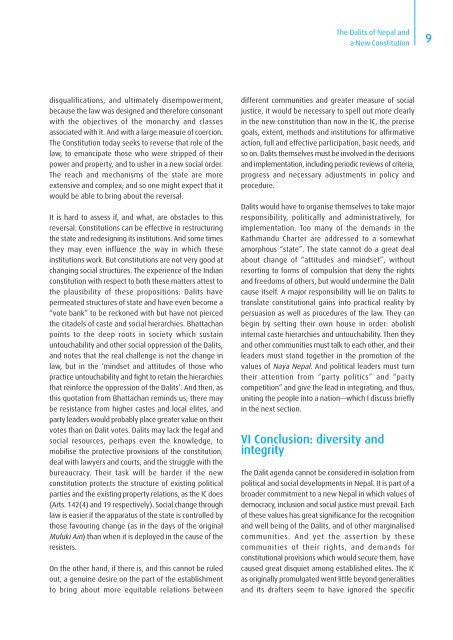The Dalits of Nepal and a New Constitution - ConstitutionNet
The Dalits of Nepal and a New Constitution - ConstitutionNet
The Dalits of Nepal and a New Constitution - ConstitutionNet
Create successful ePaper yourself
Turn your PDF publications into a flip-book with our unique Google optimized e-Paper software.
<strong>The</strong> <strong>Dalits</strong> <strong>of</strong> <strong>Nepal</strong> <strong>and</strong><br />
a <strong>New</strong> <strong>Constitution</strong><br />
9<br />
disqualifications, <strong>and</strong> ultimately disempowerment,<br />
because the law was designed <strong>and</strong> therefore consonant<br />
with the objectives <strong>of</strong> the monarchy <strong>and</strong> classes<br />
associated with it. And with a large measure <strong>of</strong> coercion.<br />
<strong>The</strong> <strong>Constitution</strong> today seeks to reverse that role <strong>of</strong> the<br />
law, to emancipate those who were stripped <strong>of</strong> their<br />
power <strong>and</strong> property, <strong>and</strong> to usher in a new social order.<br />
<strong>The</strong> reach <strong>and</strong> mechanisms <strong>of</strong> the state are more<br />
extensive <strong>and</strong> complex; <strong>and</strong> so one might expect that it<br />
would be able to bring about the reversal.<br />
It is hard to assess if, <strong>and</strong> what, are obstacles to this<br />
reversal. <strong>Constitution</strong>s can be effective in restructuring<br />
the state <strong>and</strong> redesigning its institutions. And some times<br />
they may even influence the way in which these<br />
institutions work. But constitutions are not very good at<br />
changing social structures. <strong>The</strong> experience <strong>of</strong> the Indian<br />
constitution with respect to both these matters attest to<br />
the plausibility <strong>of</strong> these propositions: <strong>Dalits</strong> have<br />
permeated structures <strong>of</strong> state <strong>and</strong> have even become a<br />
“vote bank” to be reckoned with but have not pierced<br />
the citadels <strong>of</strong> caste <strong>and</strong> social hierarchies. Bhattachan<br />
points to the deep roots in society which sustain<br />
untouchability <strong>and</strong> other social oppression <strong>of</strong> the <strong>Dalits</strong>,<br />
<strong>and</strong> notes that the real challenge is not the change in<br />
law, but in the ‘mindset <strong>and</strong> attitudes <strong>of</strong> those who<br />
practice untouchability <strong>and</strong> fight to retain the hierarchies<br />
that reinforce the oppression <strong>of</strong> the <strong>Dalits</strong>’. And then, as<br />
this quotation from Bhattachan reminds us, there may<br />
be resistance from higher castes <strong>and</strong> local elites, <strong>and</strong><br />
party leaders would probably place greater value on their<br />
votes than on Dalit votes. <strong>Dalits</strong> may lack the legal <strong>and</strong><br />
social resources, perhaps even the knowledge, to<br />
mobilise the protective provisions <strong>of</strong> the constitution,<br />
deal with lawyers <strong>and</strong> courts, <strong>and</strong> the struggle with the<br />
bureaucracy. <strong>The</strong>ir task will be harder if the new<br />
constitution protects the structure <strong>of</strong> existing political<br />
parties <strong>and</strong> the existing property relations, as the IC does<br />
(Arts. 142(4) <strong>and</strong> 19 respectively). Social change through<br />
law is easier if the apparatus <strong>of</strong> the state is controlled by<br />
those favouring change (as in the days <strong>of</strong> the original<br />
Muluki Ain) than when it is deployed in the cause <strong>of</strong> the<br />
resisters.<br />
On the other h<strong>and</strong>, if there is, <strong>and</strong> this cannot be ruled<br />
out, a genuine desire on the part <strong>of</strong> the establishment<br />
to bring about more equitable relations between<br />
different communities <strong>and</strong> greater measure <strong>of</strong> social<br />
justice, it would be necessary to spell out more clearly<br />
in the new constitution than now in the IC, the precise<br />
goals, extent, methods <strong>and</strong> institutions for affirmative<br />
action, full <strong>and</strong> effective participation, basic needs, <strong>and</strong><br />
so on. <strong>Dalits</strong> themselves must be involved in the decisions<br />
<strong>and</strong> implementation, including periodic reviews <strong>of</strong> criteria,<br />
progress <strong>and</strong> necessary adjustments in policy <strong>and</strong><br />
procedure.<br />
<strong>Dalits</strong> would have to organise themselves to take major<br />
responsibility, politically <strong>and</strong> administratively, for<br />
implementation. Too many <strong>of</strong> the dem<strong>and</strong>s in the<br />
Kathm<strong>and</strong>u Charter are addressed to a somewhat<br />
amorphous “state”. <strong>The</strong> state cannot do a great deal<br />
about change <strong>of</strong> “attitudes <strong>and</strong> mindset”, without<br />
resorting to forms <strong>of</strong> compulsion that deny the rights<br />
<strong>and</strong> freedoms <strong>of</strong> others, but would undermine the Dalit<br />
cause itself. A major responsibility will lie on <strong>Dalits</strong> to<br />
translate constitutional gains into practical reality by<br />
persuasion as well as procedures <strong>of</strong> the law. <strong>The</strong>y can<br />
begin by setting their own house in order: abolish<br />
internal caste hierarchies <strong>and</strong> untouchability. <strong>The</strong>n they<br />
<strong>and</strong> other communities must talk to each other, <strong>and</strong> their<br />
leaders must st<strong>and</strong> together in the promotion <strong>of</strong> the<br />
values <strong>of</strong> Naya <strong>Nepal</strong>. And political leaders must turn<br />
their attention from “party politics” <strong>and</strong> “party<br />
competition” <strong>and</strong> give the lead in integrating, <strong>and</strong> thus,<br />
uniting the people into a nation—which I discuss briefly<br />
in the next section.<br />
VI Conclusion: diversity <strong>and</strong><br />
integrity<br />
<strong>The</strong> Dalit agenda cannot be considered in isolation from<br />
political <strong>and</strong> social developments in <strong>Nepal</strong>. It is part <strong>of</strong> a<br />
broader commitment to a new <strong>Nepal</strong> in which values <strong>of</strong><br />
democracy, inclusion <strong>and</strong> social justice must prevail. Each<br />
<strong>of</strong> these values has great significance for the recognition<br />
<strong>and</strong> well being <strong>of</strong> the <strong>Dalits</strong>, <strong>and</strong> <strong>of</strong> other marginalised<br />
communities. And yet the assertion by these<br />
communities <strong>of</strong> their rights, <strong>and</strong> dem<strong>and</strong>s for<br />
constitutional provisions which would secure them, have<br />
caused great disquiet among established elites. <strong>The</strong> IC<br />
as originally promulgated went little beyond generalities<br />
<strong>and</strong> its drafters seem to have ignored the specific








![g]k fnsf blntx? / gofF ;+l jwfg](https://img.yumpu.com/49483602/1/184x260/gk-fnsf-blntx-goff-l-jwfg.jpg?quality=85)



![+ljwfg;ef, /fHosf]k'g](https://img.yumpu.com/41604075/1/184x260/-ljwfgef-fhosfkg.jpg?quality=85)




